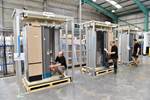TRB Lightweight Structures manufactures prepreg material in-house to streamline part production
Company reaches 25,000-part milestone via rapid-cure prepreg technology.

Photo Credit: TRB Lightweight Structures
TRB Lightweight Structures (TRB, Huntingdon, U.K.) announced on April 15 that it has begun manufacturing its own prepreg material to improve performance, cost and lead times for its composite parts. The company has already produced and shipped 25,000 parts using this proprietary, rapid-cure prepreg technology.
In late 2020, TRB announced a new production process to generate continuous fiber, thermoset composite parts at high volume for automotive markets. To deliver on that promise, the company built its own prepreg machines, and is developing a family of resins to support component manufacturing, including resins optimized for rapid cure, FST (UL94-V0) and high-temperature applications. TRB has emphasized that it is not selling its prepreg commercially, but is instead focused on streamlining its production process for the components it manufactures. This reportedly enables the company to decrease costs and lead times by reducing the number of vendors involved and eliminating minimum order quantities, while also improving manufacturing efficiency.
“By making our own prepreg, we are able to tune the material selection to precisely match what is needed for each customer,” says Andrew Dugmore, VP of business development at TRB. “We can create an optimal mix of fabric weight, colored surface finish and resin properties, as well as incorporating additional materials — such as EMI shielding, and electrical and thermal insulation — during the layup process.”
Related Content
-
Natural fiber composites: Growing to fit sustainability needs
Led by global and industry-wide sustainability goals, commercial interest in flax and hemp fiber-reinforced composites grows into higher-performance, higher-volume applications.
-
Sulapac introduces Sulapac Flow 1.7 to replace PLA, ABS and PP in FDM, FGF
Available as filament and granules for extrusion, new wood composite matches properties yet is compostable, eliminates microplastics and reduces carbon footprint.
-
TU Munich develops cuboidal conformable tanks using carbon fiber composites for increased hydrogen storage
Flat tank enabling standard platform for BEV and FCEV uses thermoplastic and thermoset composites, overwrapped skeleton design in pursuit of 25% more H2 storage.













